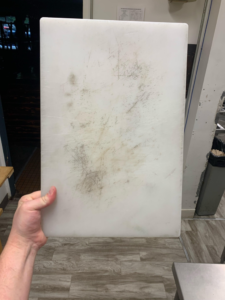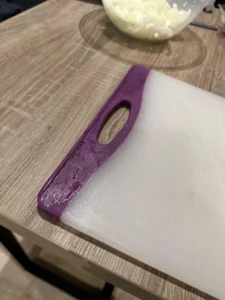How to Properly Clean Plastic Cutting Boards

Plastic cutting boards are a staple in many kitchens due to their durability and ease of maintenance. However, over time, they can develop stains, odors, and bacteria if not cleaned properly. Here are some effective ways to ensure your plastic cutting boards remain hygienic and in good condition.
1. Basic Cleaning Method
Materials Needed:
Dish soap
Warm water
Sponge or soft cloth
Start by rinsing the cutting board under warm water to remove any food particles. Apply a few drops of dish soap and use a sponge or soft cloth to scrub the surface thoroughly. Pay special attention to grooves where food particles might hide. Rinse well with warm water and let the board air dry completely.
2. Vinegar and Baking Soda
Materials Needed:
White vinegar
Baking soda
Scrubbing pad
For stubborn stains and odors, create a paste with baking soda and a small amount of water. Sprinkle the paste on the stained areas and scrub with a scrubbing pad. Rinse thoroughly afterward. Alternatively, you can spray white vinegar on the board, let it sit for a few minutes, then wipe it down to disinfect and remove odors.

3. Lemon Juice and Salt
Materials Needed:
Lemon
Coarse salt
Another natural cleaning method involves using lemon juice and salt. Sprinkle coarse salt over the surface of the cutting board, then cut a lemon in half and use it to scrub the salt into the board. The acidity of the lemon helps eliminate bacteria, while the salt acts as an abrasive cleaner. Rinse with warm water and dry.
4. Hydrogen Peroxide
Materials Needed:
Hydrogen peroxide (3% solution)
Spray bottle
For a deeper clean, you can use hydrogen peroxide. Spray the cutting board with the solution and let it sit for a few minutes to disinfect. Rinse thoroughly and allow it to dry. This method is particularly useful for removing odors and bacteria.

5. Dishwasher Cleaning
Most plastic cutting boards are dishwasher safe. To clean them in the dishwasher, place the board on the top rack and run a normal cycle with your regular detergent. This method is convenient and effective for ensuring thorough cleaning.
6. Regular Maintenance
To keep your plastic cutting boards in great shape, consider the following tips:
Clean the board immediately after use to prevent stains and odors from setting in.
Rotate the use of multiple boards for different food types (e.g., meats, vegetables) to avoid cross-contamination.
Replace cutting boards showing deep cuts or heavy staining, as they can harbor bacteria.
Conclusion
By following these effective cleaning methods, you can maintain the hygiene and longevity of your plastic cutting boards. Regular care not only ensures food safety but also keeps your kitchen looking its best. Try these techniques to enjoy cleaner, fresher cutting boards for all your culinary adventures!





